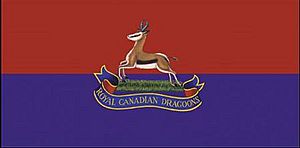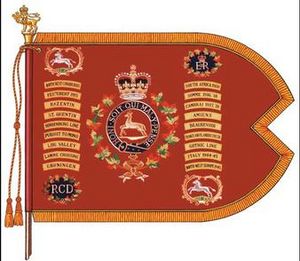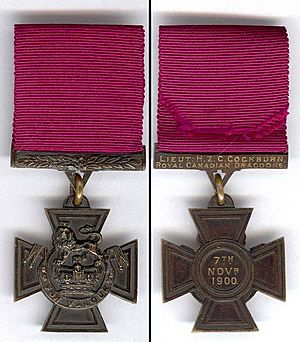Royal Canadian Dragoons facts for kids
Quick facts for kids The Royal Canadian Dragoons |
|
|---|---|
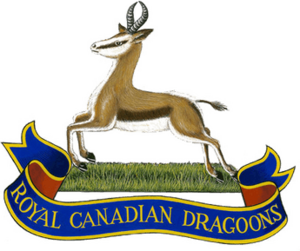
Regimental badge
|
|
| Active | 1883–present |
| Country | Canada |
| Branch | Canadian Army |
| Type | Armoured |
| Role | Armoured cavalry |
| Size | One regiment (4 squadrons and headquarters squadrons) |
| Part of | 2 Canadian Mechanized Brigade Group |
| Garrison/HQ | CFB Petawawa |
| Motto(s) | Audax et celer |
| March | "Monsieur Beaucaire" "Light of Foot" (Dismounted) |
| Mascot(s) | Springbok |
| Anniversaries | Leeuwarden Lelielontein |
| Equipment | See § Equipment |
| Engagements | North-West Rebellion Second Boer War First World War Second World War War in Afghanistan |
| Battle honours | See § Battle honours |
| Commanders | |
| Colonel-in-chief | Charles III |
| Colonel of the regiment | Major-General Dean Milner, CMM, MSC, CD (Retired) |
| Commanding officer | Lieutenant-Colonel N. Forsyth, CD |
| Insignia | |
| NATO Map Symbol |  |
| Abbreviation | RCD |
The Royal Canadian Dragoons (RCD) is a very important armoured regiment in the Canadian Army. It's the oldest and most senior armoured regiment in Canada. The RCD is one of three armoured regiments that are part of Canada's full-time military, known as the Regular Force. They belong to the Royal Canadian Armoured Corps.
The RCD's special leader, called the colonel-in-chief, is Charles III, who is the King of Canada. The regiment also has a "Colonel of the Regiment," who is Major-General Dean Milner (retired). The person in charge right now is Lieutenant-Colonel N. Forsyth. The regiment is made up of different groups called "squadrons." Some squadrons are "light cavalry," meaning they move fast. Others help support the regiment.
Contents
The History of the Royal Canadian Dragoons
How the Dragoons Started
The Royal Canadian Dragoons began on December 21, 1883. Back then, they were called the Cavalry School Corps. They were Canada's very first full-time, professional cavalry unit. Cavalry units ride horses! The first leader was Captain J.F. Turnbull. He brought in experienced instructors from the British Army to help train the new soldiers.
Helping in the North-West Rebellion
In 1885, the Cavalry School Corps helped during the North-West Rebellion. They were sent to patrol an area in Saskatchewan. Their job was to keep communication lines safe. They didn't get into any big battles during this time.
Serving in the South African War
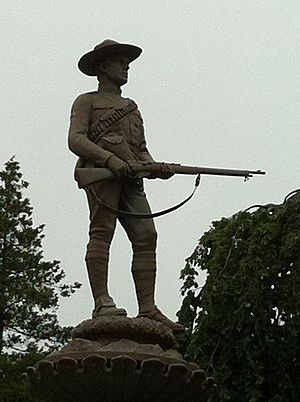
The Dragoons were sent to South Africa for the Second Boer War in 1900. They were called the 1st Battalion, Canadian Mounted Rifles. They had 19 officers and 371 soldiers, along with their horses. They fought in many actions and marched over 2,700 kilometers (about 1,700 miles)! Because of their bravery, their name was changed to the Royal Canadian Dragoons while they were still in South Africa.
During this war, many of their junior officers were killed or wounded. Three Dragoons earned the Victoria Cross, which is the highest award for bravery. This happened at the Battle of Lelielontein on November 7, 1900. Their actions there were incredibly brave and saved their unit.
Fighting in the First World War
When the First World War started in 1914, the Dragoons were sent to England and then to France. At first, they fought on foot like infantry soldiers. But in 1916, they got their horses back and returned to their role as cavalry. They continued to fight in France and Belgium until the war ended.
The Second World War and Beyond
At the start of the Second World War, the Dragoons were still using horses. But by 1940, they switched to armoured vehicles. They became an armoured car regiment. They went to Britain in 1941 and then landed in Sicily in 1943, moving to Italy in 1944. In Italy, the mountains made it hard for their vehicles, so they often fought on foot as infantry.
In 1945, the regiment moved to North-West Europe. They were heavily involved in battles in the Netherlands and Germany. The RCD was the first Allied unit to reach the North Sea through Holland. They famously helped free the city of Leeuwarden. Their fighting was so intense that two of their sergeants earned the Distinguished Conduct Medal for bravely getting supplies to their squadrons.
Serving in Korea
After the Korean War ended, a part of the Dragoons, called D Squadron, served in Korea in 1954. They used M4A3E8 Sherman tanks. They were the last Canadian soldiers to use these tanks in a real operation.
Peacekeeping Missions (UN and NATO)
The Royal Canadian Dragoons have played a big part in peacekeeping missions around the world.
- From 1957 to 1967, they sent troops to the United Nations Emergency Force (UNEF) in Egypt. They used Ferret scout cars.
- They were also among the first Canadian troops sent to Cyprus as part of a UN peacekeeping mission. They served there many times.
- From 1970 to 1987, the regiment was stationed in West Germany as part of NATO. They used different tanks and reconnaissance vehicles.
- In the 1990s, they served in Yugoslavia with the UN and NATO, helping with peacekeeping efforts in that region.
Modern Operations: Afghanistan and Ukraine
The Royal Canadian Dragoons sent many soldiers and tank crews to Afghanistan from 2002 to 2014. They played a vital role in the Canadian efforts there. Sadly, several Dragoons lost their lives during this mission.
More recently, the Dragoons have been involved in Operation Unifier in Ukraine. They have sent officers and soldiers to help train the Ukrainian Armed Forces.
Special Recognition
In 1983, Canada Post released a special stamp featuring The Royal Canadian Dragoons. This was part of a series celebrating Canadian military regiments.
The Springbok Cap Badge
Since 1913, the cap badge of The Royal Canadian Dragoons has featured a springbok, which is a type of antelope. This special badge honors their service in South Africa.
There's a story that during the Second Boer War, a sentry noticed springboks acting strangely. This supposedly warned the Dragoons about an enemy attack, which they then defeated. While this story is a popular legend, there isn't official proof of it. However, the regiment asked King Edward VII to change their badge to the springbok, and it was approved in 1913.
Battle Honours
Battle honours are special awards given to military units for their bravery and success in battles. The Royal Canadian Dragoons have many battle honours, which are listed below. The ones in bold are so important that they are displayed on the regimental flag, called a guidon. In 2022, a new guidon was presented that includes the battle honour for their service in Afghanistan.
North-West Rebellion
South African War
First World War
Second World War
- Liri Valley
- Gothic Line
- Lamone Crossing
- Italy, 1944–1945
- Groningen
- North-West Europe, 1945
Southwest Asia
- Afghanistan
Victoria Cross Heroes
On November 7, 1900, during the Second Boer War, the Royal Canadian Dragoons were part of the Battle of Lelielontein. They were protecting a retreating column and two important cannons. The enemy tried very hard to capture the cannons, even charging on horseback. But the Dragoons fought bravely and saved the cannons and the column. For their amazing courage that day, three members of The Royal Canadian Dragoons were awarded the Victoria Cross:
- Lieutenant H.Z.C. Cockburn
- Lieutenant R.E.W. Turner
- Sergeant E.J.G. Holland
Other Connections
The Royal Canadian Dragoons have special connections with other military units:
- They are allied with The Blues and Royals from the United Kingdom.
- They have a "Bond of Friendship" with the 3rd Squadron, 71st Cavalry Regiment (Light Horse) from the United States.
See also
- List of Canadian organizations with royal patronage
- The Canadian Crown and the Canadian Forces
- List of units of the Canadian Army


